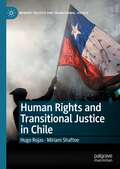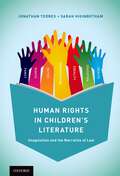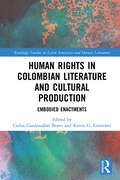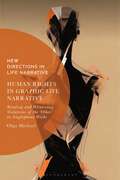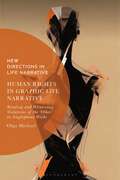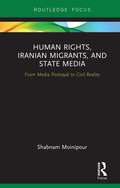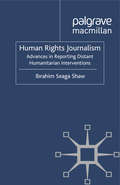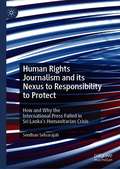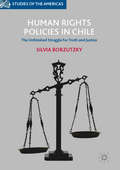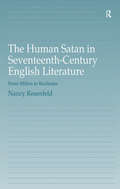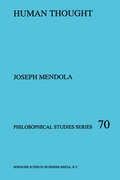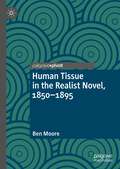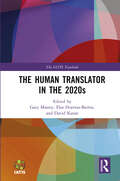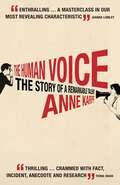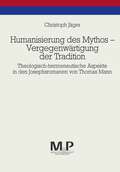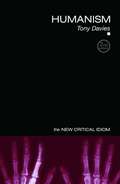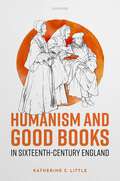- Table View
- List View
Human Rights and Transitional Justice in Chile (Memory Politics and Transitional Justice)
by Hugo Rojas Miriam ShaftoeThis book offers a synthesis of the main achievements and pending challenges during the thirty years of transitional justice in Chile after Augusto Pinochet’s dictatorship. The Chilean experience provides useful comparative perspectives for researchers, students and human rights activists engaged in transitional justice processes around the world. The first chapter explains the theoretical foundations of human rights and transitional justice. The second chapter discusses the main historical milestones in Chile’s recent history which have defined the course of the process of transitional justice. The following chapters provide an overview of the key elements of transitional justice in Chile: truth, reparations, memory, justice, and guarantees of non-repetition.
Human Rights in Children's Literature: Imagination and the Narrative of Law
by Jonathan Todres Sarah HiginbothamHow can children grow to realize their inherent rights and respect the rights of others? In this book, authors Jonathan Todres and Sarah Higinbotham explore this question through both human rights law and children's literature. Both international and domestic law affirm that children have rights, but how are these norms disseminated so that they make a difference in children's lives? Human rights education research demonstrates that when children learn about human rights, they exhibit greater self-esteem and respect the rights of others. The Convention on the Rights of the Child -- the most widely-ratified human rights treaty -- not only ensures that children have rights, it also requires that states make those rights "widely known, by appropriate and active means, to adults and children alike." This first-of-its-kind requirement for a human rights treaty indicates that if rights are to be meaningful to the lives of children, then government and civil society must engage with those rights in ways that are relevant to children. Human Rights in Children's Literature investigates children's rights under international law -- identity and family rights, the right to be heard, the right to be free from discrimination, and other civil, political, economic, social and cultural rights -- and considers the way in which those rights are embedded in children's literature from Peter Rabbit to Horton Hears a Who! to Harry Potter. This book traverses children's rights law, literary theory, and human rights education to argue that in order for children to fully realize their human rights, they first have to imagine and understand them.
Human Rights in Children's Literature: Imagination and the Narrative of Law
by Jonathan Todres Sarah HiginbothamHow can children grow to realize their inherent rights and respect the rights of others? In this book, authors Jonathan Todres and Sarah Higinbotham explore this question through both human rights law and children's literature. Both international and domestic law affirm that children have rights, but how are these norms disseminated so that they make a difference in children's lives? Human rights education research demonstrates that when children learn about human rights, they exhibit greater self-esteem and respect the rights of others. The Convention on the Rights of the Child -- the most widely-ratified human rights treaty -- not only ensures that children have rights, it also requires that states make those rights "widely known, by appropriate and active means, to adults and children alike." This first-of-its-kind requirement for a human rights treaty indicates that if rights are to be meaningful to the lives of children, then government and civil society must engage with those rights in ways that are relevant to children. Human Rights in Children's Literature investigates children's rights under international law -- identity and family rights, the right to be heard, the right to be free from discrimination, and other civil, political, economic, social and cultural rights -- and considers the way in which those rights are embedded in children's literature from Peter Rabbit to Horton Hears a Who! to Harry Potter. This book traverses children's rights law, literary theory, and human rights education to argue that in order for children to fully realize their human rights, they first have to imagine and understand them.
Human Rights in Colombian Literature and Cultural Production: Embodied Enactments (Routledge Studies in Latin American and Iberian Literature)
by Carlos Gardeazábal BravoThis volume explores how Colombian novelists, artists, performers, activists, musicians, and others seek to enact—to perform, to stage, to represent—human rights situations that are otherwise enacted discursively, that is, made public or official, in juridical and political realms in which justice often remains an illusory or promised future. In order to probe how cultural production embodies the tensions between the abstract universality of human rights and the materiality of violations on individual human bodies and on determined groups, the volume asks the following questions: How does the transmission of historical traumas of Colombia’s past, through human rights narratives in various forms, inform the debates around the subjects of rights, truth and memory, remembrance and forgetting, and the construction of citizenship through solidarity and collective struggles for justice? What are the different roles taken by cultural products in the interstices among rights, laws, and social justice within different contexts of state violence and states of exception? What are alternative perspectives, sources, and (micro)histories from Colombia of the creation, evolution, and practice of human rights? How does the human rights discourse interface with notions of environmental justice, especially in the face of global climate change, regional (neo)extractivism, the implementation of megaprojects, and ongoing post-accord thefts and (re)appropriations of land? Through a wide range of disciplinary lenses, the different chapters explore counter-hegemonic concepts of human rights, decolonial options struggling against oppression and market logic, and alternative discourses of human dignity and emancipation within the pluriverse.
Human Rights in Colombian Literature and Cultural Production: Embodied Enactments (Routledge Studies in Latin American and Iberian Literature)
by Carlos Gardeazábal Bravo Kevin G. GuerrieriThis volume explores how Colombian novelists, artists, performers, activists, musicians, and others seek to enact—to perform, to stage, to represent—human rights situations that are otherwise enacted discursively, that is, made public or official, in juridical and political realms in which justice often remains an illusory or promised future. In order to probe how cultural production embodies the tensions between the abstract universality of human rights and the materiality of violations on individual human bodies and on determined groups, the volume asks the following questions: How does the transmission of historical traumas of Colombia’s past, through human rights narratives in various forms, inform the debates around the subjects of rights, truth and memory, remembrance and forgetting, and the construction of citizenship through solidarity and collective struggles for justice? What are the different roles taken by cultural products in the interstices among rights, laws, and social justice within different contexts of state violence and states of exception? What are alternative perspectives, sources, and (micro)histories from Colombia of the creation, evolution, and practice of human rights? How does the human rights discourse interface with notions of environmental justice, especially in the face of global climate change, regional (neo)extractivism, the implementation of megaprojects, and ongoing post-accord thefts and (re)appropriations of land? Through a wide range of disciplinary lenses, the different chapters explore counter-hegemonic concepts of human rights, decolonial options struggling against oppression and market logic, and alternative discourses of human dignity and emancipation within the pluriverse.
Human Rights in Graphic Life Narrative: Reading and Witnessing Violations of the 'Other' in Anglophone Works (New Directions in Life Narrative)
by Dr Olga MichaelSurveying print and digital graphic life narratives about people who become 'othered' within Western contexts, this book investigates how comics and graphic novels witness human rights transgressions in contemporary Anglophone culture and how they can promote social justice. With thought given to how the graphic form can offer a powerful counterpoint to the legal, humanitarian and media discourses that dehumanise the most violated and dispossessed, but also how these works may unconsciously reproduce Western neo-colonial presentations of the 'other,' Olga Michael focuses on gender, death, space, and border violence within graphic life narratives depicting suffering across different geo- and biopolitical locations. Combining the familiar with the lesser-known, this book covers works by artists such as Joe Sacco, Thi Bui, Mia Kirshner, Phoebe Gloeckner, Kamel Khélif, Francesca Sanna, Gabi Froden, Benjamin Dix and Lindsay Pollock, as well as Safdar Ahmed and Ali Dorani/Eaten Fish. Interdisciplinary in its consideration of life writing, comics and human rights studies, and comparative in approach, this book explores such topics as the aesthetics of visualised suffering; spatial articulations of human rights violations; the occurrence of violations whilst crossing borders; the gendered dimensions of visually captured violence; and how human rights discourses intersect with graphic depictions of the dead. In so doing, Michael establishes how to read human rights and social justice comics in relation to an escalating global crisis and deftly complicates negotiations of 'otherness.' A vitally important work to the humanities sector, this book underscores the significance of postcolonial decolonized reading acts as forms of secondary witness.
Human Rights in Graphic Life Narrative: Reading and Witnessing Violations of the 'Other' in Anglophone Works (New Directions in Life Narrative)
by Dr Olga MichaelSurveying print and digital graphic life narratives about people who become 'othered' within Western contexts, this book investigates how comics and graphic novels witness human rights transgressions in contemporary Anglophone culture and how they can promote social justice. With thought given to how the graphic form can offer a powerful counterpoint to the legal, humanitarian and media discourses that dehumanise the most violated and dispossessed, but also how these works may unconsciously reproduce Western neo-colonial presentations of the 'other,' Olga Michael focuses on gender, death, space, and border violence within graphic life narratives depicting suffering across different geo- and biopolitical locations. Combining the familiar with the lesser-known, this book covers works by artists such as Joe Sacco, Thi Bui, Mia Kirshner, Phoebe Gloeckner, Kamel Khélif, Francesca Sanna, Gabi Froden, Benjamin Dix and Lindsay Pollock, as well as Safdar Ahmed and Ali Dorani/Eaten Fish. Interdisciplinary in its consideration of life writing, comics and human rights studies, and comparative in approach, this book explores such topics as the aesthetics of visualised suffering; spatial articulations of human rights violations; the occurrence of violations whilst crossing borders; the gendered dimensions of visually captured violence; and how human rights discourses intersect with graphic depictions of the dead. In so doing, Michael establishes how to read human rights and social justice comics in relation to an escalating global crisis and deftly complicates negotiations of 'otherness.' A vitally important work to the humanities sector, this book underscores the significance of postcolonial decolonized reading acts as forms of secondary witness.
Human Rights, Iranian Migrants, and State Media: From Media Portrayal to Civil Reality (Routledge Studies in Media, Communication, and Politics)
by Shabnam MoinipourThis book offers a detailed analysis of the Islamic Republic of Iran’s approach towards human rights in the media. It looks at the state-owned and state-controlled Islamic Republic of Iran Broadcasting (IRIB), employing content analysis and multimodal critical discourse analysis to explore its underlying strategies in portraying the international rights norms. The book also features analysis of surveys and interviews of recent Iranian migrants to determine the extent to which the Iranian public is aware of human rights principles and their views on whether and how the international rights norms are portrayed on IRIB.
Human Rights, Iranian Migrants, and State Media: From Media Portrayal to Civil Reality (Routledge Studies in Media, Communication, and Politics)
by Shabnam MoinipourThis book offers a detailed analysis of the Islamic Republic of Iran’s approach towards human rights in the media. It looks at the state-owned and state-controlled Islamic Republic of Iran Broadcasting (IRIB), employing content analysis and multimodal critical discourse analysis to explore its underlying strategies in portraying the international rights norms. The book also features analysis of surveys and interviews of recent Iranian migrants to determine the extent to which the Iranian public is aware of human rights principles and their views on whether and how the international rights norms are portrayed on IRIB.
Human Rights Journalism: Advances in Reporting Distant Humanitarian Interventions
by I. ShawShaw argues that journalism should focus on deconstructing the underlying structural and cultural causes of political violence such as poverty, famine and human trafficking, and play a proactive (preventative), rather than reactive (prescriptive) role in humanitarian intervention.
Human Rights Journalism and its Nexus to Responsibility to Protect: How and Why the International Press Failed in Sri Lanka’s Humanitarian Crisis
by Senthan SelvarajahThis book takes a holistic approach by capturing the various perspectives and viewpoints concerning the theory and practice of Human Rights Journalism. Firstly, this book helps fill the epistemological vacuum present in Human Rights Journalism by proposing ‘pragmatic objectivity’ within the critical constructivist epistemology. Secondly, it defines the Human Rights Journalism-Responsibility to Protect nexus by identifying five key elements. Thirdly, it proposes a Human Rights Journalism-Responsibility to Protect conceptual model, which illustrates how an embedded human rights focussed media strategy can be designed. Fourthly, this book proposes two novel quantitative analysis tools called the ‘Framing Matrix’ and the ‘Multimodal Discourse Analysis Matrix’ that are equipped to deal with a big sample size over a long period of time. These tools are used to examine the practice of Human Rights Journalism and the typology of news stories of distant sufferings. Finally, it provides a scientific explanation for those in search of the answer to why one of the worst humanitarian crises in the world, which took place in Sri Lanka in 2009, did not create any global compassion or garner attention.
Human Rights Policies in Chile: The Unfinished Struggle for Truth and Justice
by Silvia BorzutzkyThis book analyses Chile’s “truth and justice” policies implemented between 1990 and 2013. The book’s central assumption is that human rights policies are a form of public policy and consequently they are the product of compromises among different political actors. Because of their political nature, these incomplete “truth and justice” policies instead of satisfying the victims’ demands and providing a mechanism for closure and reconciliation generate new demands and new policies and actions. However, these new policies and actions are partially satisfactory to those pursuing justice and the truth and unacceptable to those trying to protect the impunity structure built by General Pinochet and his supporters. Thus, while the 40th anniversary of the violent military coup that brought General Pinochet to power serves as a milestone with which to end this policy analysis, Chile’s human rights historical drama is unfinished and likely to generate new demands for truth and justice policies.
Human Rights Policies in Chile: The Unfinished Struggle for Truth and Justice
by Silvia BorzutzkyThis book analyses Chile’s “truth and justice” policies implemented between 1990 and 2013. The book’s central assumption is that human rights policies are a form of public policy and consequently they are the product of compromises among different political actors. Because of their political nature, these incomplete “truth and justice” policies instead of satisfying the victims’ demands and providing a mechanism for closure and reconciliation generate new demands and new policies and actions. However, these new policies and actions are partially satisfactory to those pursuing justice and the truth and unacceptable to those trying to protect the impunity structure built by General Pinochet and his supporters. Thus, while the 40th anniversary of the violent military coup that brought General Pinochet to power serves as a milestone with which to end this policy analysis, Chile’s human rights historical drama is unfinished and likely to generate new demands for truth and justice policies.
The Human Satan in Seventeenth-Century English Literature: From Milton to Rochester
by Nancy RosenfeldFramed by an understanding that the very concept of what defines the human is often influenced by Renaissance and early modern texts, this book establishes the beginning of the literary development of the satanic form into a humanized form in the seventeenth century. This development is centered on characters and poetry of four seventeenth-century writers: the Satan character in John Milton's Paradise Lost and Paradise Regained, the Tempter in John Bunyan's Grace Abounding to the Chief of Sinners and Diabolus in Bunyan's The Holy War, the poetry of John Wilmot, earl of Rochester, and Dorimant in George Etherege's Man of Mode. The initial understanding of this development is through a sequential reading of Milton and Bunyan which examines the Satan character as an archetype-in-the-making, building upon each to work so that the character metamorphoses from a groveling serpent and fallen archangel to a humanized form embodying the human impulses necessary to commit evil. Rosenfeld then argues that this development continues in Restoration literature, showing that both Rochester and Etherege build upon their literary predecessors to develop the satanic figure towards greater humanity. Ultimately she demonstrates that these writers, taken collectively, have imbued Satan with the characteristics that define the human. This book includes as an epilogue a discussion of Samson in Milton's Samson Agonistes as a later seventeenth-century avatar of the humanized satanic form, providing an example for understanding a stock literary character in the light of early modern texts.
The Human Satan in Seventeenth-Century English Literature: From Milton to Rochester
by Nancy RosenfeldFramed by an understanding that the very concept of what defines the human is often influenced by Renaissance and early modern texts, this book establishes the beginning of the literary development of the satanic form into a humanized form in the seventeenth century. This development is centered on characters and poetry of four seventeenth-century writers: the Satan character in John Milton's Paradise Lost and Paradise Regained, the Tempter in John Bunyan's Grace Abounding to the Chief of Sinners and Diabolus in Bunyan's The Holy War, the poetry of John Wilmot, earl of Rochester, and Dorimant in George Etherege's Man of Mode. The initial understanding of this development is through a sequential reading of Milton and Bunyan which examines the Satan character as an archetype-in-the-making, building upon each to work so that the character metamorphoses from a groveling serpent and fallen archangel to a humanized form embodying the human impulses necessary to commit evil. Rosenfeld then argues that this development continues in Restoration literature, showing that both Rochester and Etherege build upon their literary predecessors to develop the satanic figure towards greater humanity. Ultimately she demonstrates that these writers, taken collectively, have imbued Satan with the characteristics that define the human. This book includes as an epilogue a discussion of Samson in Milton's Samson Agonistes as a later seventeenth-century avatar of the humanized satanic form, providing an example for understanding a stock literary character in the light of early modern texts.
Human Thought (Philosophical Studies Series #70)
by J.R. MendolaConscious experience and thought content are customarily treated as distinct problems. This book argues that they are not. Part One develops a chastened empiricist theory of content, which cedes to experience a crucial role in rooting the contents of thoughts, but deploys an expanded conception of experience and of the ways in which contents may be rooted in experience. Part Two shows how, were the world as we experience it to be, our neurophysiology would be sufficient to constitute capacities for the range of intuitive thoughts recognized by Part One. Part Three argues that physics has shown that our experience is not veridical, and that this implies that no completely plausible account of how we have thoughts is comprehensible by humans. Yet this leaves thoughts not especially suspect, because such considerations also imply that all positive and contingent human conceptions of anything are false.
Human Tissue in the Realist Novel, 1850-1895 (Palgrave Studies in Literature, Science and Medicine)
by Ben MooreThis Pivot engages with current debates about anthropocentrism and the Anthropocene to propose a reappraisal of the realist novel in the second half of the nineteenth century. Through three case studies, it argues for ‘human tissue’ as a conceptual tool for reading that brings together biology, literature and questions of layering. This new approach is shown to be especially salient to the Victorian period, when the application of ‘tissue’ to biology first emerges. The book is distinctive in bringing together theoretical concerns around realism and the Anthropocene – two major topics in literary criticism – and presenting a new methodology to approach this conjunction, demonstrated through original readings of Charles Kingsley, George Eliot, and Emile Zola and two English-language writers he influenced (George Moore and Vernon Lee).
The Human Translator in the 2020s (The IATIS Yearbook)
by Gary Massey Elsa Huertas-Barros David KatanHas the language industry of the 21st century been racing ahead of the translation profession and leaving translators behind? Or are translators adapting to new sociotechnical realities and societal demands, and if so, how? The chapters in this volume seek to shed light on the profiles and position of human translators in the current decade. This collection draws together the work of leading authors to reflect on the constantly evolving language industry. The eight chapters present new perspectives on, and concepts of, translation in a digital world. They highlight the shifts taking place in the sociotechnical environment of translation and the need to address changing buyer needs and market demands with new services, profiles and training. In doing so, they share a common focus on the added value that human translators can and do bring to bear as adaptive, creative, digitally literate experts. Addressing an international readership, this volume is of interest to advanced students and researchers in translation and interpreting studies, and professionals in the global language industry.
The Human Translator in the 2020s (The IATIS Yearbook)
by Gary Massey Elsa Huertas-Barros David KatanHas the language industry of the 21st century been racing ahead of the translation profession and leaving translators behind? Or are translators adapting to new sociotechnical realities and societal demands, and if so, how? The chapters in this volume seek to shed light on the profiles and position of human translators in the current decade. This collection draws together the work of leading authors to reflect on the constantly evolving language industry. The eight chapters present new perspectives on, and concepts of, translation in a digital world. They highlight the shifts taking place in the sociotechnical environment of translation and the need to address changing buyer needs and market demands with new services, profiles and training. In doing so, they share a common focus on the added value that human translators can and do bring to bear as adaptive, creative, digitally literate experts. Addressing an international readership, this volume is of interest to advanced students and researchers in translation and interpreting studies, and professionals in the global language industry.
The Human Voice: The Story of a Remarkable Talent
by Anne KarpfWhy has the female voice deepened over the last fifty years? Who talks more, men or women? How can a baby in the womb distinguish between different voices?The human voice is the personal and social glue that binds us, and the most important sound in our lives. The moment we open our mouth we leak information about our biological, psychological and social status. Babies use it to establish emotional ties and acquire language, adults to decode mood and meaning in intimate and professional relationships. Far from being rendered redundant by modern technology, the human voice has enormous and enduring significance.
Humanisierung des Mythos - Vergegenwärtigung der Tradition: Theologisch-hermeneutische Aspekte in den Josephsromanen von Thomas Mann. M & P Schriftenreihe
by Christoph JägerHumanism (The New Critical Idiom)
by Tony DaviesDefinitions of humanism have evolved throughout the centuries as the term has been adopted for a variety of purposes – literary, cultural and political – and reactions against humanism have contributed to movements such as postmodernism and anti-humanism. Tony Davies offers a clear introduction to the many uses of this influential yet complex concept and this second edition extends his discussion to include: a comprehensive history of the development of the term and its influences theories of post-humanism, cybernetics and artificial intelligence implications of concepts of humanism and post-humanism on political and religious activism discussion of the key figures in humanist debate from Erasmus and Milton to Chomsky, Heidegger and Foucault a new glossary and further reading section. With clear explanations and poignant discussions, this volume is essential reading for anyone approaching the study of humanism, post-humanism or critical theory.
Humanism (The New Critical Idiom)
by Tony DaviesDefinitions of humanism have evolved throughout the centuries as the term has been adopted for a variety of purposes – literary, cultural and political – and reactions against humanism have contributed to movements such as postmodernism and anti-humanism. Tony Davies offers a clear introduction to the many uses of this influential yet complex concept and this second edition extends his discussion to include: a comprehensive history of the development of the term and its influences theories of post-humanism, cybernetics and artificial intelligence implications of concepts of humanism and post-humanism on political and religious activism discussion of the key figures in humanist debate from Erasmus and Milton to Chomsky, Heidegger and Foucault a new glossary and further reading section. With clear explanations and poignant discussions, this volume is essential reading for anyone approaching the study of humanism, post-humanism or critical theory.
Humanism and Good Books in Sixteenth-Century England
by Katherine C. LittleThis book explores sixteenth-century humanism as an origin for the idea of literature as good, even great, books. It argues that humanists located the value of books not only in the goodness of their writing-their eloquence—but also in their capacity to shape readers in good and bad behavior, thoughts, and feelings, in other words, in their morality. To approach humanism in this way, by attending to its moral interests, is to provide a new perspective on periodization, the transition from the Middle Ages to the Renaissance / early modern. That is, humanists did not so much rupture with medieval ideas about literature or with medieval models as they adapted and altered them, offering a new confidence about an old idea: the moral instructiveness of pagan, classical texts for Christian readers. This revaluation of literature was a double-edged sword. On the one hand, humanist confidence inspired authors to invent their own good books—good in style and morals—in morality plays such as Everyman and the Christian Terence tradition and in educational treatises such as Sir Thomas Elyot's Boke of the Governour. On the other hand, humanism placed a new burden on authors, requiring their work to teach and delight. In the wake of humanism, authors struggled to articulate the value of their work for readers, returning to a pre-humanist path that they associated with Geoffrey Chaucer. This medieval-inflected doubt pervades the late sixteenth-century writings of the most prolific and influential Elizabethans-Robert Greene, George Gascoigne, and Edmund Spenser.
Humanism and Good Books in Sixteenth-Century England
by Katherine C. LittleThis book explores sixteenth-century humanism as an origin for the idea of literature as good, even great, books. It argues that humanists located the value of books not only in the goodness of their writing-their eloquence—but also in their capacity to shape readers in good and bad behavior, thoughts, and feelings, in other words, in their morality. To approach humanism in this way, by attending to its moral interests, is to provide a new perspective on periodization, the transition from the Middle Ages to the Renaissance / early modern. That is, humanists did not so much rupture with medieval ideas about literature or with medieval models as they adapted and altered them, offering a new confidence about an old idea: the moral instructiveness of pagan, classical texts for Christian readers. This revaluation of literature was a double-edged sword. On the one hand, humanist confidence inspired authors to invent their own good books—good in style and morals—in morality plays such as Everyman and the Christian Terence tradition and in educational treatises such as Sir Thomas Elyot's Boke of the Governour. On the other hand, humanism placed a new burden on authors, requiring their work to teach and delight. In the wake of humanism, authors struggled to articulate the value of their work for readers, returning to a pre-humanist path that they associated with Geoffrey Chaucer. This medieval-inflected doubt pervades the late sixteenth-century writings of the most prolific and influential Elizabethans-Robert Greene, George Gascoigne, and Edmund Spenser.
